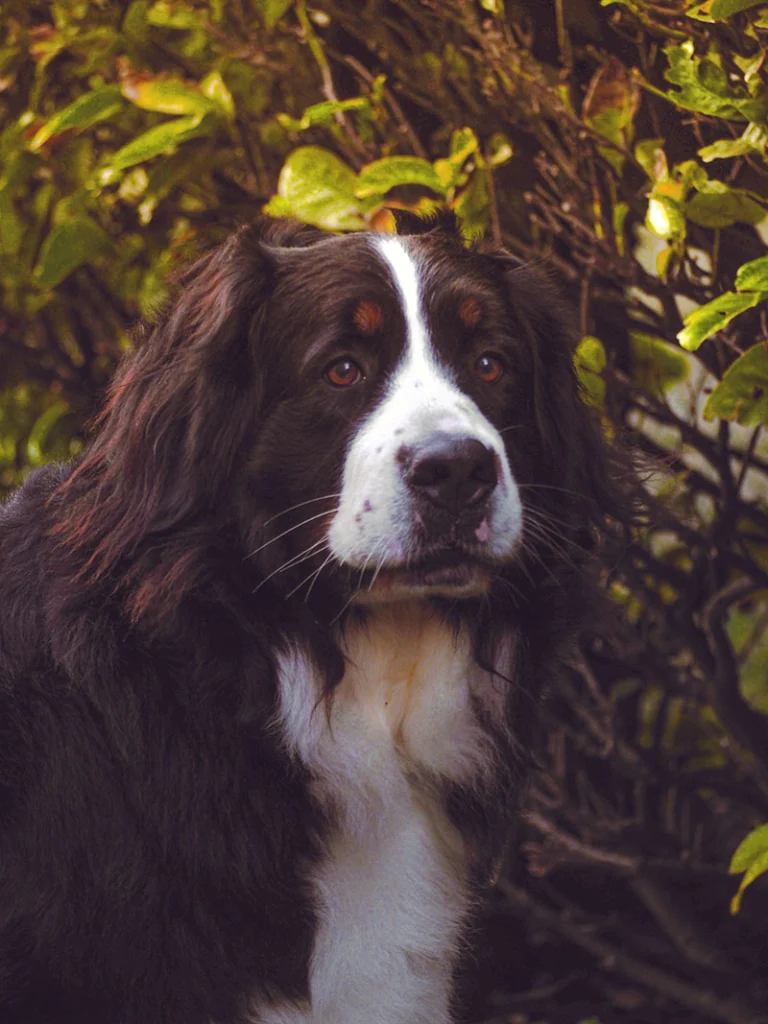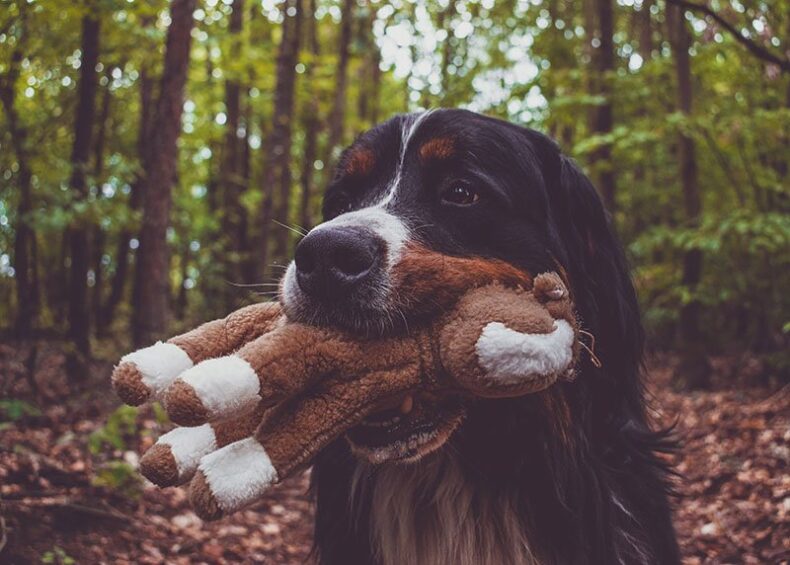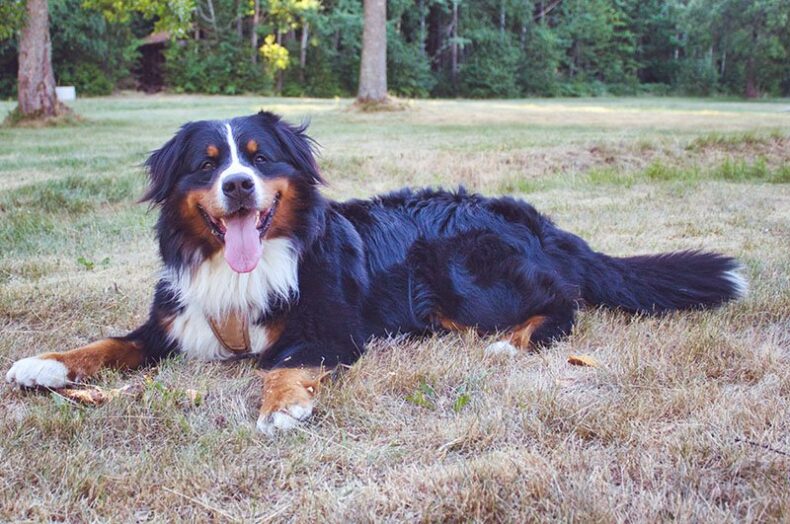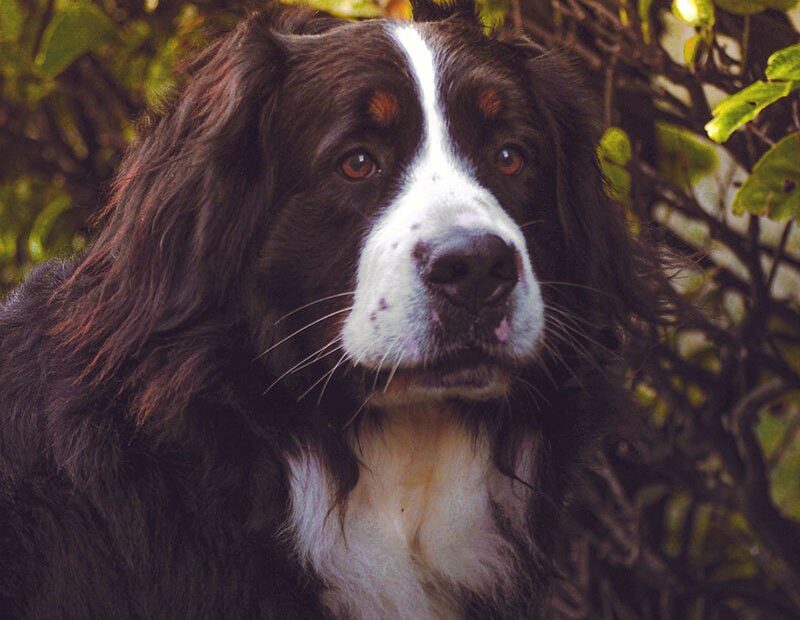A Bernese Mountain Dog has a very distinct look and is roughly the size and shape of a st. Bernard. Yet, there are a few distinct differences between the two breeds. The Bernese Mountain Dog too is a strong working dog originally bred to assist farmers in Switzerland, Europe. Since then, these dogs have become popular as pets as they are affectionate and also highly intelligent and they are very receptive to training.
The Bernese Mountain Dog is a very sociable breed and as a result can be a very lovable addition to any household. But it is important to understand how much exercise this breed of dog requires – especially if you are considering taking one on!

It is important to understand this breed has been deliberately bred to withstand cold, mountainous conditions and, as a result, has thick long fur of black and white so you must consider this when you are exercising your dog in warm weather. Your dog may struggle and it’s important to watch out the signs of exhaustion or heat exhaustion in your dog.
So, how much exercise does my Bernese Mountain Dog need?
This type of dog is very high energy and does require at least half an hour to a whole 60 minutes of exercise every single day for optimal energy expenditure. It is recommended that you take them for a walk or expend at least an hour and a half of energy each day.
This breed is particularly susceptible to obesity so it is critical that they are occupied both mentally and physically with daily exercise. You should also consider what you’re feeding your dog to make sure that they don’t become overweight. Keeping your dog fit and healthy requires them to expend as much energy as they’re taking in.
Activities and exercise for your Bernese dog
There are certain key elements to provide your dog on a daily basis. One of which is their daily walk which is mandatory with most dogs. They also need to participate in activities that keep them mentally stimulated this can alleviate boredom and prevent issues with destructive behaviour.
The amount of exercise described here is intended for an adult Bernese Mountain Dog. If you have a puppy, then adjust the requirements accordingly. A puppy is still developing and has softer bones and joints. The same goes for senior dogs and as they get older you will find that they don’t have as much energy as they once did. But it is important to still be taken for a daily walk to keep their muscles and joints supple and limit their chances of becoming obese.
A Bernese Mountain Dog doesn’t have the life expectancy of other breeds and they are expected to live between 6 or even 8 years. St Bernards are similar in this respect, as these dogs tend to be large and have joint problems also.

Should you exercise your dog directly after they have been fed?
A Bernese Mountain Dog is quite unique in its structure and size and due to the structure of the skeleton, they can be prone to digestive problems and bloating if they are exercised too soon after they have been fed a meal.
These digestive problems can cause air to build up your dog’s stomach and cause discomfort. It may also lead to a twisted stomach. If you are worried your dog has suffered from any kind of twisting of the upper stomach, then immediately see a vet.
A daily walk for a Bernese Mountain Dog
Taking your Bernese Mountain Dog for a walk is essential for their well-being as well as their (and your!) general fitness. Your dog may encounter all sorts of mental stimulation, such as other dogs, fresh air and the experience of being outdoors and other stimuli it provides. This breed of dog should be taken for a walk the last at least half an hour. This is a general rule however and you should monitor your dog to see how they are getting on.
If they seem to be struggling or panting too much or find that they are lagging behind in any way then you should in the walk and return home. You can split this walk up into two parts if you like – each being 15 to 20-minutes. All dogs like to follow a daily schedule, so make sure you build a routine around important events like his or her daily walk.

If you have managed to train your Bernese Mountain dog sufficiently, then off-leash can be permitted. If they do not respond to your call, then you can look into a retractable lead that allows them to roam whilst still being under your control. You should have no problem training your Bernese Mountain Dog, however, as they are generally very easy to train and respond to your commands easily.
A Bernese Mountain Dog is prone to joint problems, so we do not recommend that you get a dog backpack or add any extra weight to their body. A standard walk should be perfectly sufficient for a dog of this mountain breed.
Exercises for a Bernese Mountain Dog
As well as normal walking, your Bernese Mountain Dog might also enjoy some extra activities and fun playtime. Remember, it is important for their fitness as well as their mental health that they are engaged in stimulating activities.
Take a look at the following ideas to keep Bernese Mountain Dog active and happy.
Playing with other dogs
Make sure your dog has the opportunity to play with other dogs. They don’t necessarily have to be a similar breed – any dog will provide mental stimulation and him or her to develop social skills that may be important later on. As a breed, Bernese Mountain dogs are very sociable and happy to socialise with other dogs – always supervise your dog when they are around a strange dog.
Swimming
Bernese Mountain Dog, as we mentioned before, are prone to joint problems as other large dogs are, so swimming can provide great exercise. This will take the pressure off these tricky areas, making your dog weightless in the water. Check your local area for dog swimming pools that are dedicated to pooches having fun in the water!
Any body of water that is without current should be safe for your dog to exercise happily. Maybe sure you supervise your dog and they stay close to the edge and under your supervision at all times.
The great outdoors
Hiking and outdoor trails may be the ideal exercise for a Bernese Mountain Dog, as they were designed to cover mountainous terrain. As a result, this breed is great at being out and about in the wild outdoors and this may provide you with great company as you enjoy your adventurous trek!
Stair exercises
This is a great way for your dog to expend energy if you are housebound. You should begin this exercise at the bottom of the stairs and get your dog to stay where they are. Throw up a ball or their favourite toy to the top of the staircase and then command them to go and fetch.
They will expend energy on the uprise, and when they descend, they should go at a slower speed in order to prevent any injuries from occurring running up.
Any kind of gradient can strengthen the front legs of your Bernese Mountain Dog. As they come back down the staircase you will find that they are using the opposite muscles to keep them steady. You may have experienced this effect if you have walked up and down a very steep hill yourself.
Digging around
This breed of dog really does enjoy digging holes! As do Labradors and other kinds of dog. This is an Instinct that is built into your dog’s psyche.
This instinct may become problematic if they start digging where you don’t want. If you’re near an outdoor area such as a beach then this provides an ideal place to work out this instinct.
It is impossible to stop a dog if they wish to engage in instinctive behavior, but you can reroute it by finding them an alternative you can find toys that cater to this incident. See our post on toys for dogs that love to go for a good dig.
My Bernese Mountain Dog is a puppy – how much exercise does he need?
All the advice we have mentioned so far refers to an adult dog of this breed. Puppies need a certain amount of exercise that differs from their adult version. Their soft bones, joints and muscles are still developing and taking your puppy for a long walk or engaging in an activity that’s too strenuous may do harm to these delicate areas.
The best way to wear out a puppy and exercise him – as well provide adequate mental stimulation – are toys that they will engage them. Allowing your puppy to engage with other puppies or dogs that are known to be friendly is a great way for them to burn energy and develop too.
A daily walk for a Bernese Mountain Puppy
The most important part of your puppy walk when they are young is for them to learn and discover all the sights and smells of being outside. Just as long as this is in a safe environment – you may want to keep the puppy on leash in the situation. If your puppy is 3 months old or under then it is unlikely that you should be taking them outside where they may encounter other dogs if they have not had all the appropriate vaccinations yet. Check with your vet to see if that is the case.
There is a general rule for walking puppies that should be observed. This is applicable to this breed too. You should generally walk a puppy at least 5 minutes for each month of their age. To put this into practice, a 6-month old puppy should be walked for around 30-minutes.
This should be perfectly sufficient for their exercise requirements
How much exercise does a senior Bernese Mountain Dog require?
As your dog matures he or she will be becoming more mellow and less active naturally. They will likely have less energy and you’ll find that they most will be happy with a shorter walk.
It is important, however, that they still get enough exercise to keep their joints and muscles from becoming stiff. You may find that your Bernese Mountain Dog has issues with arthritis as they get older. In this case, it can be tricky to balance being active with allowing them enough time to rest and keeping pressure off his or her joints, so take this into account when exercising them.
Final thoughts on your Bernese Mountain dogs exercise requirements
Your mountain dog had its origins in the mountains of Switzerland. Originally bred as a working dog, that has a very thick coat to withstand the cold temperatures
In general, this breed is very friendly very sociable and have a great deal of strength when out and about. Exercise your Bernese Mountain Dog for at least half an hour a day and engage them with activities to enrich their experience. If you find your dog engages in destructive behaviour, then you may wish to provide them with more mental stimulation and an outlet for their instinct to dig holes.
We would really love to you hear from any pooch owners that have a Bernese Mountain Dog so please get in touch via the comments section below.
